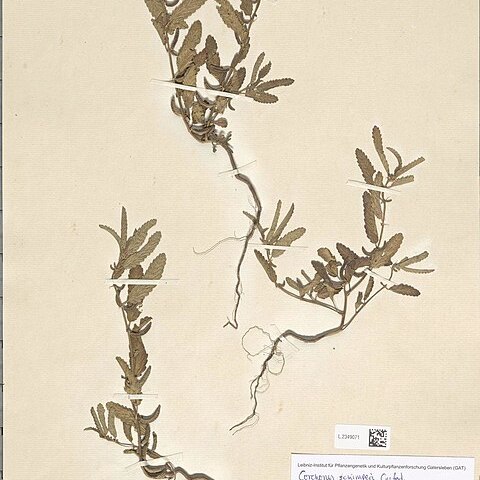A herb. It lies along the ground. It is an annual plant. The branches have a line of curled hairs along one side. The leaves are oblong to sword shaped. They are 5 cm long by 1.5 cm wide. There are a few hairs on the edges. There are rounded teeth along the edge. The flowers are in clusters of 1-3 in the axils of the leaves. The fruit is a 3 angled capsule. It can be 2.5 cm long.
Annual herb. Stems erect or procumbent, Leaves with blade narrowly ovate or oblong, 10-50 x 7-15 mm, base rounded or broadly cuneate, margins crenate. Flowers: in 1-3-flowered extra-axillary fascicles; sepals ± 3-5 mm long; petals as long as sepals, yellow; Nov.-May. Fruit up to 25 mm long usually curved, not held erect, 3-angled, angles muricate or sharply toothed.
Leaf-lamina 1–5 × 0·7–1·5 cm., lanceolate or oblong, apex rounded, margin crenate or crenate-serrate, base broadly cuneate or rounded, sometimes rather asymmetric, sparsely pilose at least on the nerves beneath and at the margins; petiole up to 7 mm. long, pubescent on the upper side; stipules 2–3 mm. long, setaceous, sparsely ciliate-pubescent.
Inflorescences of 1–3-flowered extra-axillary fascicles, the peduncles usually obsolete; pedicels up to 2 mm. long, pubescent, twisted in fruit; bracts 1–2 mm. long, setaceous.
Capsule up to 2·5 cm. long, straight or often curved, trigonous, with the angles muricate or sharply toothed, 3-valved, with many seeds; beak very short, undivided and blunt.
Erect to prostrate annual herb. Peduncles obsolete. Capsules up to 25 mm long, usually curved, not held erect, angles muricate or sharply toothed. Flowers yellow.
Petals yellow, the same length as the sepals, narrowly obovate to obovate, with a very short minutely ciliolate basal claw less than 0·5 mm. long or obsolete.
Annual herb branching from low down, at first erect but later branches often prostrate; branches with a line of short curly hairs on one side.
Ovary trigonously cylindric, 3-locular, very minutely setulose-pubescent; style 2·5 mm. long, glabrous, very slender.
Sepals c. 3–5 mm. long, linear to very narrowly elliptic, shortly acuminate at the apex, pubescent on the back.
Androgynophore and annulus very minute, c. 0·25 mm. long.
Seeds c. 1·4 × 0·75 mm., dark brown, subcylindric.
Stamens numerous.

